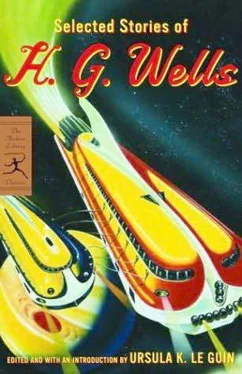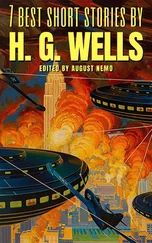Wells was writing his “futuristic” tales before the twentieth century got going, when technology hadn’t run so far ahead of the writer— when, indeed, the writer could run ahead of the technology. Three of the five stories in this section are exactly that, the writer telling the engineers where they’re going to go. These stories, like many of Jules Verne’s, are genuinely predictive.
Since about the time it got called science fiction—the late 1920s—science fiction has not, in fact, been able to predict anything much at all. What science fiction can do and does do is offer not predictions but warnings, speculations, and alternatives.
Much of the strength of Wells’s predictive visions lies there: as warnings, as visions of power out of control, as dreams of Armageddon. “The Argonauts of the Air” was published in 1895, eight years before the Wright brothers took off at Kitty Hawk. It tells of the first trial of a flying machine—the word aeroplane or airplane wasn’t current then.
The preparations, the machinery, the flight are splendidly, starkly imagined. Although the author speaks of the conquest of the air as being perhaps “costlier than the greatest war,” his mood is adventurous, hopeful. Man will fly: it is only a matter of time. Less time, possibly, than he expected.
“In the Abyss” was written decades before William Beebe went that first half-mile down in his bathysphere. The details of the imagined technology are explicit and convincing, as is the descent into the depths of the sea. What the explorer of the abyss discovers there is a little less plausible. Though explained in the finest deadpan fakescientific lingo (“descendants like ourselves of the great Theriomorpha of the New Red Sandstone age”), the creatures of the deep belong to Wells’s cheerfully spooky mode. I doubt he really thought we’d meet them.
“The Star” is the purest example of a kind of story that has been written on its model ever since. Nothing fantastic or implausible: a perfectly possible event. No protagonists, no individual experience. A little necessary scientific jargon, then simple description, immense in scope, rapid in pace, of catastrophe approaching the whole earth. And a few final paragraphs of wry and unexpected summing-up. Wells wrote it in 1897. I doubt its brevity and intensity have been equaled.
He included “The Star” in his 1913 selection of his own short stories, but omitted the “Argonauts of the Air,” “In the Abyss,” and the next story here, “The Land Ironclads.” He could not have imagined how poignant his predictions, both on the nail and amiss, might seem to people a hundred years later.
“The Land Ironclads,” published in 1903, demands some imaginative repositioning on the part of the reader. It’s not easy to pretend the First World War won’t happen for ten years yet, and that the word tank means nothing but a container for liquids. It may take a little mental stretch to see what the argument about “Manhood Versus Machinery” meant—and means.
The last story in this section, “A Dream of Armageddon”— technological, predictive, terrible—a story about air war—was written in 1901. Still two years to go before Kitty Hawk. And the whole twentieth century and all its wars to come. Here the engineering and the visionary imaginations merge into something approaching prophecy.
Wells now has the words aeroplane and propellor, though the things did not exist (yet).
But war existed.
He tells his tale as a dream recounted by a chance acquaintance to the narrator, thus doubly distancing the emotional, almost hysterical story, which is weirdly complicated by the narrator’s trivial questions, by interruptions from the dreamer’s memories of the waking world, and by the narrator’s awareness of all that is going on around the conversation. “A Dream of Armageddon” is a troubled, troubling story, half out of control, not easy to get out of your head.
One saw Monson’s Flying-Machine from the windows of the trains passing either along the South-Western main line or along the line between Wimbledon and Worcester Park,—to be more exact, one saw the huge scaffoldings which limited the flight of the apparatus. They rose over the tree-tops, a massive alley of interlacing iron and timber, and an enormous web of ropes and tackle, extending the best part of two miles. From the Leatherhead branch this alley was foreshortened and in part hidden by a hill with villas; but from the main line one had it in profile, a complex tangle of girders and curving bars, very impressive to the excursionists from Portsmouth and Southampton and the West. Monson had taken up the work where Maxim had left it, had gone on at first with an utter contempt for the journalistic wit and ignorance that had irritated and hampered his predecessor, and had spent (it was said) rather more than half his immense fortune upon his experiments. The results, to an impatient generation, seemed inconsiderable. When some five years had passed after the growth of the colossal iron groves at Worcester Park, and Monson still failed to put in a fluttering appearance over Trafalgar Square, even the Isle of Wight trippers felt their liberty to smile. And such intelligent people as did not consider Monson a fool stricken with the mania for invention, denounced him as being (for no particular reason) a self-advertising quack.
Yet now and again a morning trainload of season-ticket holders would see a white monster rush headlong through the airy tracery of guides and bars, and hear the further stays, nettings, and buffers snap, creak, and groan with the impact of the blow. Then there would be an efflorescence of black-set white-rimmed faces along the sides of the train, and the morning papers would be neglected for a vigorous discussion of the possibility of flying (in which nothing new was ever said by any chance), until the train reached Waterloo, and its cargo of season-ticket holders dispersed themselves over London. Or the fathers and mothers in some multitudinous train of weary excursionists returning exhausted from a day of rest by the sea, would find the dark fabric, standing out against the evening sky, useful in diverting some bilious child from its introspection, and be suddenly startled by the swift transit of a huge black flapping shape that strained upward against the guides. It was a great and forcible thing beyond dispute, and excellent for conversation; yet, all the same, it was but flying in leading-strings, and most of those who witnessed it scarcely counted its flight as flying. More of a switchback it seemed to the run of the folk.
Monson, I say, did not trouble himself very keenly about the opinions of the press at first. But possibly he, even, had formed but a poor idea of the time it would take before the tactics of flying were mastered, the swift assured adjustment of the big soaring shape to every gust and chance movement of the air; nor had he clearly reckoned the money this prolonged struggle against gravitation would cost him. And he was not so pachydermatous as he seemed. Secretly he had his periodical bundles of cuttings sent him by Romeike, he had his periodical reminders from his banker; and if he did not mind the initial ridicule and scepticism, he felt the growing neglect as the months went by and the money dribbled away. Time was when Monson had sent the enterprising journalist, keen after readable matter, empty from his gates. But when the enterprising journalist ceased from troubling, Monson was anything but satisfied in his heart of hearts. Still day by day the work went on, and the multitudinous subtle difficulties of the steering diminished in number. Day by day, too, the money trickled away, until his balance was no longer a matter of hundreds of thousands, but of tens. And at last came an anniversary.
Читать дальше












